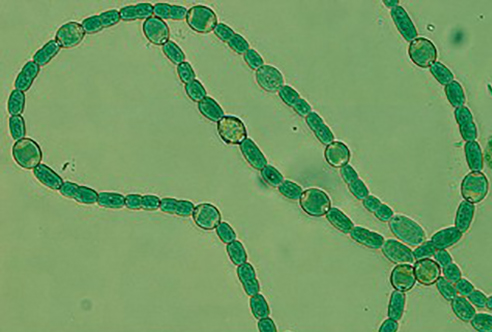![Light micrograph of cyanobacteria from the <i>Anabaena</i> genus. [DOE]” /><br />
<span class=](https://genengnews.com/wp-content/uploads/2018/08/anaaz1941062042-1.jpg) Light micrograph of cyanobacteria from the Anabaena genus. [DOE]
Light micrograph of cyanobacteria from the Anabaena genus. [DOE]
Viruses have often been described as the ultimate parasite, shedding all of their nonessential parts and leaving behind an extremely efficient genetic transfer apparatus. Phage viruses have evolved to infect various bacteria proficiently and hijack their replication machinery to make more viruses. Yet, this often doesn’t preclude a different virus from concomitantly infecting the same bacterium and competing with or overtaking the original phage invader.
However now, researchers from the University of British Columbia (UBC) have recently described their findings surrounding a phage virus that infects major freshwater bacteria, which appears to use stolen bits of immune system DNA to highjack its host's immune response. Specifically, the investigators found that cyanophage N1 carries a CRISPR DNA sequence, which is generally used by bacteria to fight off viral infection.
“Here we present the first genomic characterization of viruses infecting Nostoc, a genus of ecologically important cyanobacteria that are widespread in freshwater,” the authors wrote. “Cyanophage N-1 encodes a CRISPR array that is transcribed during infection and is similar to the DR5 family of CRISPRs commonly found in cyanobacteria. The presence of a host-related CRISPR array in a cyanophage suggests that the phage can transfer the CRISPR among related cyanobacteria and thereby provide resistance to infection with competing phages.”
“This is the first evidence we've seen that a virus can donate an immunity system via CRISPR,” explained senior study author and University of British Columbia virologist Curtis Suttle, Ph.D. “This is like a hacker compromising a computer system, and then immediately patching it to ensure other hackers can't break in.”
CRISPR’s— clustered regularly interspaced short palindromic repeats— are libraries of DNA typically used by bacteria to identify, and then destroy, infecting viruses. In the past several years, researchers have adapted the bacterial defense mechanism as a gene editing and manipulation technique with great therapeutic potential.
The UBC team stated that the N1 virus likely uses the theft to help cyanobacteria—from the ecologically important Nostoc and Anabaena genera—to fight off infection by other viruses, while continuing to be a suitable host for itself.
“Bacteria and their viruses have a shared evolutionary history stretching for billions of years,” Dr. Suttle noted. “So at some point along the way N1 stole a defensive CRISPR array from Nostoc or a close relative.”
The findings from this study were published recently in mBio in an article entitled “Viruses Infecting a Freshwater Filamentous Cyanobacterium (Nostoc sp.) Encode a Functional CRISPR Array and a Proteobacterial DNA Polymerase B.”
Both groups of cyanobacteria are abundant members of habitats ranging from the bottom of ice-covered polar lakes and hypertrophic coastal lagoons to rice paddy soils and rock-pool communities. Their ancestors were responsible for producing the oxygen on Earth, and close relatives of Nostoc are still responsible for providing a huge portion of the air we breathe.
“Filamentous cyanobacteria belonging to the genus Nostoc are widespread and ecologically important in freshwater, yet little is known about the genomic content of their viruses,” the authors remarked. “This first genomic analysis of cyanophages infecting filamentous freshwater cyanobacteria reveals that their gene content is unlike that of other cyanophages.”






